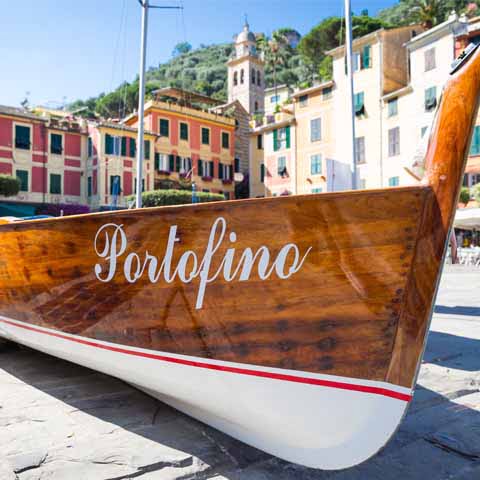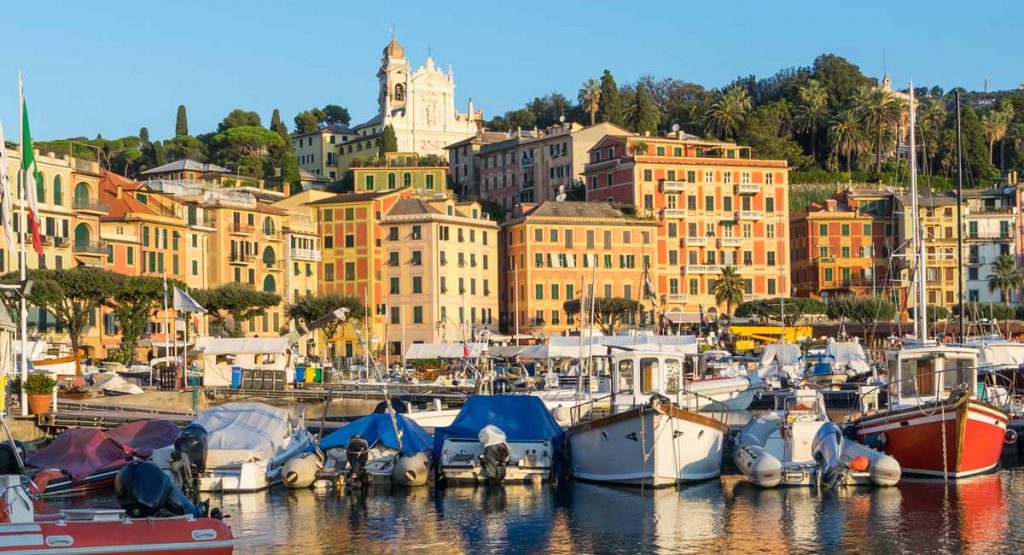The history of Portofino dates back to the Roman Empire, or perhaps even further. It was first written about by Pliny the Elder sometime in the first century AD, where he described the region as Portus Delphini for the many pods of dolphins that swam around the coastlines of the Ligurian Sea.
Later, it would be written about by Saint Adelaide of Italy, who would assign it to the Abbey of San Fruttuoso di Capodimonte. From there, the town would change hands many times over the next thousand years before being acquired by the Kingdom of Italy in the mid-nineteenth century during the Italian Unification.
Throughout most of its history, Portofino was primarily a fishing town. Indeed, to this day, it retains a great part of its heritage as a fishing village, demonstrated by the many small fishing boats that can be seen sailing around its trademark harbor. However, starting in the late nineteenth century and peaking in the 1950s, the town became known for another industry: tourism. In the 1890s Portofino became a major tourist destination for travelers from other parts of Europe – particularly from Victorian England. The British adored Portofino for its relaxed nature and its gorgeous climate, with the sunsets over the Riviera being talked about in poetry and music for centuries.
Portofino became so popular as a tourist destination that the Welsh architect Sir Clough Williams-Ellis went out of his way to try and recreate the feel of Portofino, as well as other Mediterranean villages, in the form of a tourist village called Portmeirion in North Wales. Though Williams-Ellis denied that Portofino was his only inspiration, he often sung the praises of the town, having been quoted as once saying, “How should I not have fallen for Portofino? Indeed, its image remained with me as an almost perfect example of the man-made adornment and use of an exquisite site.”
Later, in the 1950s, Portofino became a premiere destination for artists and musicians, as well as film directors who would take to using the town’s iconic buildings, streets, and harbors as backdrops for their movies. Around this time the main industry of Portofino officially changed over from fishing to tourism.
ART IN PORTOFINO
Portofino is not as known for its art and architecture as most other cities in Italy, though that does not mean that it is devoid of any such culture. While painting history is not as extensive in Portofino, it is made up for by its traditions rooted in sculpture.
The most famous sculpture in Portofino is the renowned Christ of the Abyss statue, which lies beneath the water in the Ligurian Sea. Created by Guido Galletti in 1954, the bronze statue stands eight feet tall and is positioned between Portofino and Camogli. The statue is dedicated to diver Dario Gonzatti and was positioned near the location where Gonzatti died while testing scuba gear. The adventurous can take a boat to the site and don scuba gear to dive at the site and see the statue firsthand.
Those that wish to take in the artistic history of Portofino without getting their feet wet, there is always the Museo del Parco; also known as the Park Museum, which houses the International Center of Open-Air Sculpture. Here in this outdoor museum that overhangs the sea, one can take in not only a breathtaking botanical garden, but also a plethora of astounding sculptures by many famed international artists, both classical and contemporary. Sculptures made of all sorts of materials, from stone to bronze to glass to steel, are featured here, and to this day more are constantly being bought and put on display.
There is also a more obscure art that is traditionally practiced by some of the people of Portofino. The ladies of Portofino practice the art of macrame lace. This tradition of creating delicately knotted lace has been passed down through the ages by nuns that originally lived in local convents. To this day, locals practice this art, and travelers can even take classes where they learn how to create this beautiful lace.
ARCHITECTURE IN PORTOFINO
For much of the Italian Renaissance, Portofino was under foreign control. As a result, there are not nearly as many of the trademark sweeping cathedrals and towers that one expects when visiting Italy.
But Portofino has a trademark architecture all its own. One cannot deny the beauty of the pastel-painted buildings that line the harbor, creating a picturesque view from nearly anywhere in the city. People who look out upon the town from the harbor are blown away by the colorful structures, like precious pieces in a fabulous mosaic.
For more individual examples of fine architecture, though, there are the churches of San Martino and San Giorgio. The former church was built in the twelfth century in the Lombard-Romanesque style but was later modified in the nineteenth century. The latter was built in Romanesque style in 1154, but it was renovated in the late seventeenth century then destroyed during World War II and rebuilt.
Atop a hill high above the Portofino harbor lies the Castello Brown. Built atop Roman foundations in the mid-1420s, the castle was designed to protect Portofino from invaders and pirates. Eventually, the castle was sold to Sir Montague Yeats Brown who transformed the castle into a private residence in 1870. One can now visit this castle and appreciate the military engineering with which the castle was built, including its cannon batteries and towers.
Hidden away in a cove that is only accessible by boat or by a two-hour walk along the mountains, one can still find the Abbey of San Fruttuoso di Capodimonte. This Abbey is a stunning example of medieval architecture and is surrounded by a beautiful beach with crystal clear waters.
Another gem is the Oratory of Nostra Signora Assunta, which dates back to the fourteenth century and is renowned for its slate portal with intricate engravings.
LITERATURE OF PORTOFINO
Portofino has inspired countless writers throughout history. During the Renaissance, renowned poet Petrarch found inspiration in Portofino, while French writer Guy de Maupassant and American writer Truman Capote are both said to have been influenced by time spent in Portofino.
In 1922, Elizabeth von Arnim wrote a famous book, The Enchanted April, after a stay in Castello Brown. Almost seventy years later, in 1991, director Mike Newell would adapt the book and film it in the very same castle.
CINEMA
Many films have been shot in Portofino, including the Hollywood comedy Come September, by Robert Mulligan, who would go on to direct To Kill a Mockingbird later in his career. Portofino was also one of the shooting locations of the 1995 film Beyond the Clouds, and in 2013 it was one of the shooting locations in Martin Scorsese’s Wolf of Wall Street.
Other movies filmed in Portofino, at least in part, include The Barefoot Contessa (1954), Una botta di vita (1988), Sognando la California (1992), Sole a catinelle (2013), and Murder Mystery (2019).
MUSIC
Portofino has been an inspiration for innumerable musicians and poets over the years. The town was the subject of the 1959 song “Love in Portofino” by Leo Chiosso and Fred Buscaglione, and in 2012, famed opera singer Andrea Bocelli performed two concerts in the Piazzetta. Footage from the concerts was edited into a film called Love in Portofino that was shown in theaters throughout the world. To this day, many musicians and singers come to Portofino to be inspired or to perform
SCIENCE
Italian engineer and inventor of the radio, Guglielmo Marconi, spent time in the Italian Riviera during the 1930s, particularly in Santa Margherita Ligure and Portofino. In fact, it is believed that Marconi installed a parabolic antenna for the first time in a small village located between Santa Margherita Ligure and Portofino.
Despite its small size, Portofino is not lacking in cultural offerings. It may not feature the plethora of grand churches and art found in other parts of Italy, but this coastal town’s historic monuments and cultural sights are renowned for their abundance of charm.
Don't just see Italy, live it.
Your dream trip to Italy has never been closer
No more endlessly scrolling travel sites. Our travel experts will craft the perfect, one-of-a-kind trip just for you.

300+
DESTINATIONS
We offer more Italian destinations than any travel site. Do and see more with Trips 2 Italy.
1 (of a kind)
ITINERARIES
Because your dream trip to Italy should be designed for you, not for the masses.
100%
PEACE OF MIND
From flights and accommodations, to food and activities - we take care of every detail.









